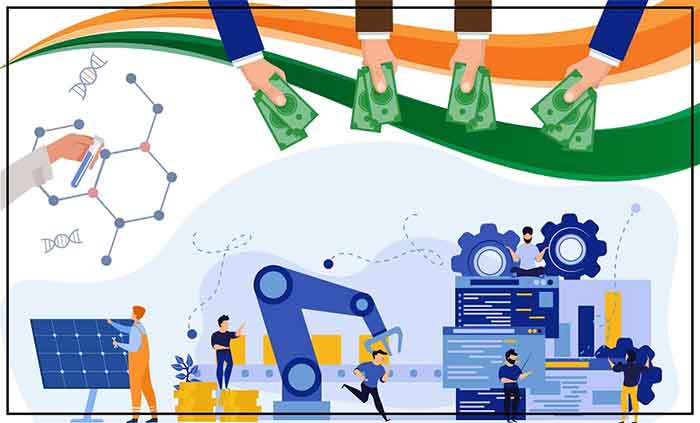
To
Smt Nirmala Sitharaman
Union Finance Minister
Dear Smt Sitharaman,
In your Budget Speech this year, you referred to the government’s decision on Productivity Linked Incentive (PLI) scheme as follows:
“The Productivity Linked Incentive in 14 sectors for achieving the vision of Atma Nirbhar Bharat has received excellent response, with potential to create 60 lakh new jobs, and an additional production of ` 30 lakh crore during next 5 years”
From what I gather from the official websites of different Ministries implementing the PLI scheme, outright subsidies under the scheme are given to private investors, linked to prescribed levels of production in phases, based on indicated levels of employment generation. The subsidy amounts are not insignificant, by any stretch of imagination. For example, subsidies for PLI schemes for the Pharma sector, automotive sector and manufacture of solar panels amount to Rs 15,000 Crores, Rs 25,938 Crores and Rs 19,500 Crores respectively. Would the government recover the subsidies already given, if the beneficiary companies fail to generate the prescribed levels of employment of the right kind? What is the quality of employment they are expected to generate?
According to an official press release dated 30-3-2022 on Electronic Hardware Manufacturing Sector, among other measures, the government had also announced a PLI scheme for Semiconductor and Display Manufacturing Schemes and announced that “the Union Cabinet chaired by Hon‟ble Prime Minister Shri Narendra Modi approved the comprehensive program with an outlay of INR 76,000 crore (> USD 10 billion) on 15.12.2021 for the development of a robust and sustainable Semiconductor and Display ecosystem in the country” Irrespective of the size of the semiconductor wafers, the subsidy in that sector would support upto 50% of the project cost (https://indianexpress.com/article/business/commodities/semiconductor-pli-support-for-50-of-project-cost-cleared-8165368/). This perhaps represents the largest level of subsidisation for any private industry till date.
The announcement of a 50% subsidy covering the project cost more or less coincided with the announcement made by the Vedanta Group of its decision to set up a semiconductor fabrication plant in Gujarat, in collaboration with Foxconn company. The total cost of this project is reported to be Rs 1,54,000 Crores. 50% of this works out to Rs 77,000 Crores, giving one the inevitable impression that the entire subsidy allocation for the semiconductor manufacturing sector would be appropriated by this company, provided it conforms to the phased production levels and prescribed employment opportunities.
The Gujarat government did not lag behind in liberally announcing similar incentives for the Vedanta-Foxconn project. It offered 75% subsidy on the value of land for the project, upto 200 acres, exemption from stamp duty and substantial tax concessions (https://www.businessinsider.in/business/news/vedanta-foxconn-semiconductor-plant-site-in-gujarat-likely-to-be-finalised-in-2-weeks-official/articleshow/94281669.cms)
While the Vedanta, Foxconn groups will no doubt work out the viability of the project from their point of view, taking into account such a liberal bonanza of incentives given by the Centre and the State, to the best of my knowledge, no such cost-benefit analysis from the society’s point of view has been attempted either by the Centre or the State, prior to committing such huge concessions. Neither of them has asked the two private groups to commit explicitly the kind of employment they will provide. It is an open secret in India that private investors initially over-state the employment benefits their investments will generate, without fulfilling the same and without facing any penalty later. In the specific case of the Vedanta-Foxconn project, the MOUs signed do not seem to prescribe penalties against the companies for not generating employment as committed.
It is interesting to compare this with more or less a similar project that Foxconn had proposed to set up in Wisconsin State in the USA in 2017, when the State Governor introduced a Bill before the State legislature committing huge subsidies and tax concessions to Foxconn in return for the company investing $10 billion and providing 13,000 jobs, with an average per employee salary of $53,875 over a period up to six years. (Incidentally, the Foxconn project in Wisconsin is yet to take off- https://www.ft.com/content/7b9b10f0-7b55-4c53-a6fe-5d76833851ba)
In order to help the State legislature understand the fiscal implications adequately, the Wisconsin Legislative Fiscal Bureau, an institution in place for providing independent professional inputs to the legislators, evaluated the costs and benefits of the project, as evident from their elaborate report dated 8-8-2017 (https://www.documentcloud.org/documents/3935827-Wisconsin-Legislative-Fiscal-Bureau-Memo-on.html).
Interestingly, the Bureau analysed the costs/benefits arising from the project for the federal and the local governments, the implications of such a highly water-intensive project diverting water from local supplies, the implications of the proposed exemptions from the laws and regulations relating to conservation of environment and wetlands and so on. The Bureau, based on a set of reasonable assumptions, projected the costs and benefits from the project over the next 25-30 years and showed that the project would not break even till the end of that timeframe.
In well functioning democracies, the legislators apparently have such professional inputs provided to them to enable them to come to decisions acceptable from the overall point of view of the society. One wishes that the concerned agencies at the Centre and in the States help set up institutions of this kind and facilitate a meaningful discussion by the legislators. The quality of a Parliamentary democracy can improve, more by creating such systems of public accountability, than by constructing glossy, cost-intensive buildings! What distresses me is that decisions involving huge subsidies like the PLI schemes are taken unilaterally without any prior independent analysis and without any meaningful discussion by the legislators!
When public funds in such a large measure are diverted to big businesses as subsidies, the executive has the responsibility of explaining to the Parliament as well as the public at large, as to why such concessions have become necessary and what kind of social benefits that can be expected, with facts and figures and a comprehensive analysis.
There are however a few important concerns about the rationale of the PLI scheme itself, which I have listed below.
- Investments get attracted, not by subsidies, but by the kind of infrastructure a State offers, the standards of good governance, availability of the right kind of human resources etc. Inappropriate subsidies tend to distort good investment decisions and, therefore, they hurt the public interest.
- Investors should be prepared to comply with rigorous standards of environmental conservation and the rule of law in India, without which a project, however beneficial it may be, can degrade the environment and damage the health of the people residing around. If the government opts for dilution of the rule of law as a compelling incentive to attract investment, it should be prepared to attract the wrong kind of investments that hurt the public interest.
- In the specific case of semiconductor fabs, in addition to surplus water availability, over and above the local needs, the location should be free from tremors, vibrations and free from air pollution. Otherwise, the project would not be able to manufacture fabs at competitive rates.
- Coming back to subsidies, it is ironic that the companies benefitting from the subsidies also happen to be those who profiteered at the cost of the public, especially during the recent Covid epidemic waves. While the Pharma companies will get Rs 15,000 Crores under the PLI, one should note that the top ten Pharma companies in India earned Rs 16,500 Crores of net profits in 2022. Subsidy only adds to their profits. If any company is to make an investment in a new area that involves undue risks, there can be special credit channels to meet their credit requirement. There is nothing new about risk capital and there are well established, financially viable ways to attract it.
- Covid has caused havoc in the lives of wage earners in rural and urban areas, crippled their meagre incomes and impoverished them like never before. It is they who need financial and institutional support, not big businesses, many of whom profiteered in many ways, exploiting the Covid effects. One would have expected the government to strengthen the social security cover for the low-income households in these hard times. However, the budget allocations during Covid and after, provide a different picture.
- The latest Economic Survey showed that there was a significantly large gap between the demand for MGNREGA wage income and the wage income provided, during and after Covid. The budget allocations made during the last few years miserably fell short of the demand. MGNREGA budget allocation for the current year is Rs 73,000 Crores, lower by 25% compared to last year’s Revised Estimate of Rs 98,000 crore and 34% lower than the actual expenditure of Rs 1,11,170 crore during 2020-21. While the MGNREGA is required to provide at least 100 days of work to a wage earner in a year, with these budget allocations, on the average, not more than 16 days employment could be created.
- The ostensible justification put forward by your Ministry for such reduced allocations for critically important schemes like the MGNREGA is that the fiscal position is tight. In the same breath, without batting an eye lid, your Ministry has announced far larger subsidies to big business by way of the PLI scheme and several tax concessions on a large-scale. For example, Table 5 of Annexure 7 of the 2022-23 Union Budget shows that tax concessions for private corporate taxpayers added upto Rs 1,03,285 Crores for 2020-21, an amount that is 41% higher than this year’s budget allocation for MGNREGA!
- While MGNREGA is a Constitutional obligation (Article 21) to be fulfilled at any cost, corporate concessions do not have any legal justification. On the other hand, corporate subsidies violate the Directive Principles {“minimising income inequalities” [Article 38(2)] and “minimising concentration of wealth” [Article 39(c)]}. Any responsible government, instead of eroding the welfare of low-income households on the dubious ground of a fiscal constraint, would tax the corporates and generate the resources needed for welfare schemes such as the MGNREGA.
Against this background, I would strongly urge upon you to
- Subject the PLI scheme in general to an independent social-cost social-benefit evaluation and place the findings before the Parliament
- In particular, commission a comprehensive evaluation of the Vedanta-Foxconn project on similar lines as a case study and place the findings before the Parliament for an elaborate discussion
- Set up an independent professional agency (like the Wisconsin Legislative Fiscal Bureau) to evaluate projects and programmes that involve public funds and place its findings from time to time before the legislature
- In the coming Budget, re-prioritise the items of expenditure, review corporate concessions and introduce a scheme of redistributive taxes to fulfil the intent underlying the Directive Principles
I hope that you will consider these suggestions with a sense of urgency and seriousness they deserve and act at the earliest.
Regards,
Yours sincerely,
E A S Sarma
Former Secretary to Govt of India
Visakhapatnam








































